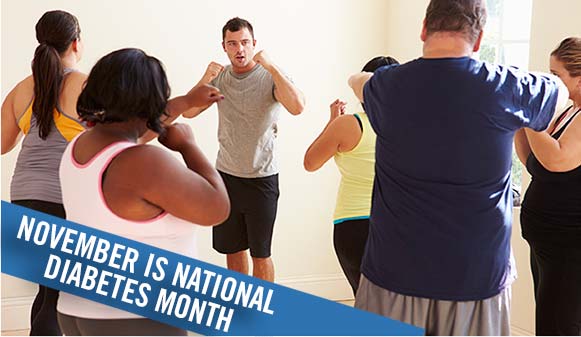
Prediabetes is akin to diagnoses like prehypertension and osteopenia in that it serves as a warning that a person is at risk for developing a much more serious condition—in this case, not only type 2 diabetes, but also cardiovascular disease, including heart disease and stroke. The Centers for Disease Control and Prevention (CDC, 2014) estimates that more than one in three American adults, or 86 million individuals, have prediabetes. The trouble is, the vast majority of these people—9 out of 10, in fact—do not know they have it.
The good news is that those with prediabetes, whether they have been diagnosed or not, can prevent the worsening of their condition and the onset of much more serious diseases by making some fairly straightforward lifestyle changes. As a fitness professional, you are ideally positioned to help your clients create and adhere to a long-term plan that will not only help ward off type 2 diabetes, but also improve their overall health and quality of life.

A Primer on Prediabetes
Stated simply, a diagnosis of prediabetes means that a person has blood glucose levels that are higher than normal, but not yet high enough to be diagnosed as diabetes. Some individuals are diagnosed after blood work is done as part of their ongoing care for other reasons. For example, consider a woman undergoing long-term hormonal therapy after completing treatment for breast cancer. As a result of secondary weight gain caused in part by the medication, she develops prediabetes, which is discovered during routine blood work. Many others will be diagnosed because they fit the profile for type 2 diabetes and their physicians specifically test for the disorder. While there are several different means of testing, which can reveal what doctors will refer to as either impaired glucose tolerance or impaired fasting glucose, the takeaway for fitness professionals is that progression to full-blown type 2 diabetes is not inevitable. That means you can play a significant role in reestablishing or preserving a prediabetic client’s health.
According to the CDC (2014), without lifestyle changes to improve their health, 15 percent to 30 percent of people with prediabetes will develop type 2 diabetes within five years. Of course, individuals cannot know they are at such high risk if they are unaware they are even prediabetic. While diagnosing prediabetes is outside a fitness professional’s defined scope of practice, you should be familiar with the following list of risk factors for prediabetes. According to the American Diabetes Association (ADA, 2012), an individual’s chances of having prediabetes go up if he or she:
- Is age 45 or older
- Is African American, Hispanic/Latino, American Indian, Asian American or Pacific Islander
- Has a parent, brother or sister with diabetes
- Is overweight
- Is physically inactive
- Has high blood pressure or takes medicine for high blood pressure
- Has low high-density lipoprotein (HDL) cholesterol and/or high triglycerides
- Is a woman who had diabetes during pregnancy
- Has been diagnosed with polycystic ovary syndrome
Of that list, age, weight and activity level will likely be discussed during the first few minutes of any new client meeting. If a new client is sedentary, over 45 and overweight, this should put you on alert that the individual may have undiagnosed prediabetes. From there, be sure to cover the other pertinent elements of that list during the initial health screening.
While diagnosis is inappropriate and outside your scope of practice, it might be best to assume certain clients are prediabetic (being sure to never imply a diagnosis to the client). For example, if a new client is a 50-year-old African-American male who is moderately obese and has a sedentary job, there is little harm in assuming he is at risk for type 2 diabetes when developing his training regimen. After all, the means of warding off the disease are probably very much in line with his goals anyway.
So what are the necessary steps to keep prediabetes from progressing to type 2 diabetes?
Doing just two things can help a person prevent or delay the onset of type 2 diabetes:
- Lose 5 percent to 7 percent of body weight, which would be 10 to 14 pounds for a 200-pound person
- Perform at least 150 minutes each week of physical activity, such as brisk walking.
These targets, particularly the process goal of exercising for 150 minutes each week, can be easily incorporated into a client’s program. It is also important to note that the guideline of accumulating 150 minutes per week of moderate-intensity exercise is in line with the standard for healthy adults, as stated in the 2008 Physical Activity Guidelines for Americans (U.S. Department of Health and Human Services, 2008).
The Importance of Physical Activity

If you have clients you suspect of being at risk for prediabetes, encourage them to visit the CDC website and take the seven-question test to determine their prediabetes score. While not definitive, this test provides an estimate of a person’s risk level. If a client is shown to be high-risk, you should encourage him or her to visit a physician.
Many people, particularly newcomers to a fitness facility, are intimidated by the “150 minutes” guideline. It’s important to do your best to ease their minds by reminding clients, particularly ones who are truly trying to get fit for the first time, that this doesn’t have to be the goal from day one. Also, as Larry Verity, Ph.D., Associate Dean of Academic Affairs in the College of Health and Human Services, and professor of exercise physiology in the School of Exercise and Nutritional Sciences at San Diego State University, reminds us, “150 minutes per week is really not very much movement. Two 10-minute walks each day totals 140 minutes with very little trouble.”
It is important to note that the benefits of even short bouts of exercise can yield tremendous benefits for a prediabetic client. “Small amounts of exercise may not have an immediate impact on weight loss,” explains Dr. Verity, “but they are significantly helpful at improving the metabolic ability of skeletal muscle to upload glucose more effectively.” After exercise, there is a period during which the muscles remain sensitive to insulin, which means they are better able to bring glucose from the bloodstream to the muscle cells, thereby lowering the blood glucose levels. This is helpful because individuals with prediabetes or diabetes have elevated blood glucose levels, and they are unable to efficiently transport this glucose into their muscle cells. If glucose remains in the blood (due in part to inactivity), it becomes harmful to the smaller blood vessels in the body. Small-vessel diseases, also called microvascular complications, are among the common outcomes of long-standing diabetes. Usually, the onset of microvascular disease progressively contributes to failure of the target tissue involved. The three different types of microvascular and neural complications are retinopathy (eye disease), nephropathy (kidney disease) and neuropathy (nerve disease). These complications of diabetes are the leading causes of new blindness, end-stage renal disease and kidney failure in adults, and nervous system damage that can lead to amputations (particularly of the foot).
Of course, there is no need to alarm a prediabetic client with talk of the potential for future foot amputation! Instead, simply develop an exercise program that will help your client lose weight and stay active for the long-term. The goal at this stage is to establish sustainable lifestyle changes that will serve to delay or even completely prevent the onset of type 2 diabetes.
Nutrition and Metabolism

Weight loss is critical for individuals with prediabetes. “Physical activity alone doesn’t burn enough calories to lose enough weight to impact metabolism,” says Dr. Verity, “so nutrient modification is essential in order to maintain metabolic health and improve the ability to burn energy.” In general, the primary goal of nutrition changes is to help improve overall health and quality of life for those with, or at high risk of, diabetes through three mechanisms:
- Optimize cardiometabolic risk profile through attainment of a hemoglobin A1C <7%; blood pressure <140/80 mmHg; low-density lipoprotein (LDL) cholesterol <100 mg/dL; triglycerides <150 mg/dL; and HDL cholesterol >40 mg/dL for men and >50 mg/dL for women.
- Achieve and maintain a healthy weight, or a 7% reduction in body weight for those who are overweight or obese.
- Delay or prevent complications associated with diabetes (Evert et al., 2013).
The levels listed above can only be measured by a physician conducting blood tests. And it is important to remember that most of the clients you work with will be unaware of their prediabetes and will not have these values on hand. The key, according to Dr. Verity, is the attainment of a balanced diet. While this is likely the goal of nearly all clients who come to you for personal training or health coaching, or who are fitness facility members, it is particularly critical for those with prediabetes. For example, many people attempting to lose weight will try a high-protein diet that reduces their intake of fat and carbohydrates in an effort to cut calories. This can be dangerous for people with diabetes or prediabetes, as protein must be broken down by the kidneys, and kidney dysfunction is a major problem for this population. Dr. Verity also reinforces the idea that everyone is different, and that fitness professionals should not be making specific nutrition recommendations to any client, especially one suspected of having a metabolic disease like diabetes.
You can, however, remind all at-risk clients that managing diabetes is a lifelong battle. And while individuals with prediabetes may not have officially begun that battle, they should set out to make lifestyle changes that are sustainable for the long haul. There is no definitive answer on how to lose weight—if there was, everyone would be doing it. Reducing caloric intake, even by a small amount, is a great start. Furthermore, reducing portion sizes and slowly incorporating minor changes to one’s diet over a long period of time can make weight loss more manageable and less intimidating to a beginning client.
The management of prediabetes and type 2 diabetes is yet another example of why fitness professionals are so valuable to the healthcare team for many clients. Disease prevention, as opposed to disease treatment, is the ideal way to maintain one’s health throughout life.
Want to make a difference in the fight against Diabetes? Check out our Diabetes Prevention Coaching online course and equip yourself with evidence-based disease-prevention strategies you can use with clients coping with, or at risk, for diabetes.
References
American Diabetes Association (2014). Diagnosing Diabetes and Learning about Prediabetes.
American Diabetes Association (2012). All About Prediabetes.
Centers for Disease Control and Prevention (2014). Prediabetes.
Evert A.B. et al. (2013). Nutrition therapy recommendations for the management of adults with diabetes. Diabetes Care, 36, 3821–3842.
U.S. Department of Health and Human Services (2008). 2008 Physical Activity Guidelines for Americans.





 by
by 





